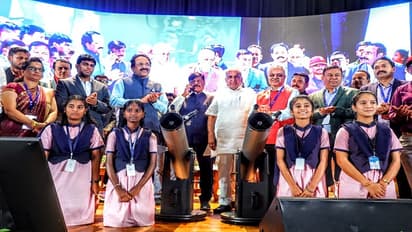'Rs 1.5 lakh crore needed for human-led Chandrayaan mission', says ISRO chief S Somanath

Synopsis
ISRO plans to send humans to the moon by 2040, with an estimated cost of Rs 1.5 lakh crore, says Chairman S. Somnath. India aims to expand its space infrastructure, increase satellite launches, and collaborate with private companies to enhance space capabilities.
The Indian Space Research Organisation (ISRO) is aiming to take a giant leap towards space exploration, with plans to send humans to the moon by 2040. However, according to ISRO Chairman S. Somnath, the cost of this ambitious mission is expected to be around Rs 1.5 lakh crore.
During an interaction with over 2 lakh students from CRIS Educational Institutions at the Ram Research Institute, Dr Babu Jagjeevan raised a question about the financial aspect of the project. Somnath explained that sending humans to the moon is a complex task, but not impossible for India.
ISRO launches India’s first analog space mission in Leh, aims to simulate extraterrestrial life
He stated that the journey to the moon is costly, noting that the United States spent 30% of its GDP during its first moon landing. Despite this, Somnath remains optimistic about India’s capabilities, stating that technological advancements will not only make the moon mission possible but also bring long-term financial benefits to the country.
Responding to concerns about the benefits of investing in space exploration, one of the students asked how this would impact the common man. Somnath reassured them by saying that ISRO generates Rs 2.5 for every rupee it spends. He pointed out that India spends approximately Rs 12,000 crore annually on its space sector, a small investment when compared to the country's vast population of 140 crores. India’s share in the global space market, worth 500 billion US dollars, currently stands at only 2%. “We need massive investment in space to increase our share,” he added.
ISRO recruitment 2024: Apply for Technician, Medical officer and other posts
India’s space infrastructure is growing steadily, with 50 satellites already in orbit. However, Somnath mentioned that India aims to have 500 satellites in the future, with a rocket launched every week. These satellites will play a crucial role in various sectors, such as internet services, weather forecasting, environmental monitoring, real estate, communications, and logistics. One of the key goals is to enable direct mobile internet connections through satellites, which ISRO is actively working on.
In addition, ISRO is collaborating with private companies to develop and manufacture satellites. Companies from the US and Europe have expressed interest in setting up operations in India, driven by the cost-efficiency of Indian space programs. These collaborations are expected to boost satellite construction, communication services, and infrastructure development.
MILESTONE ALERT! ISRO Chief S Somanath honoured with IAF world space award for Chandrayaan-3 success
The event also included remarks by Minister H.C. Mahadevappa, who highlighted the importance of science and technology in dispelling superstitions and ignorance. He encouraged children to take an interest in science and explore its vast potential.
In another initiative to promote science, the state government has distributed telescopes to 833 residential schools across the state. During the event, two residential schools were symbolically presented with telescopes, encouraging students to engage with astronomy and space science.
Stay updated with the Breaking News Today and Latest News from across India and around the world. Get real-time updates, in-depth analysis, and comprehensive coverage of India News, World News, Indian Defence News, Kerala News, and Karnataka News. From politics to current affairs, follow every major story as it unfolds. Download the Asianet News Official App from the Android Play Store and iPhone App Store for accurate and timely news updates anytime, anywhere.